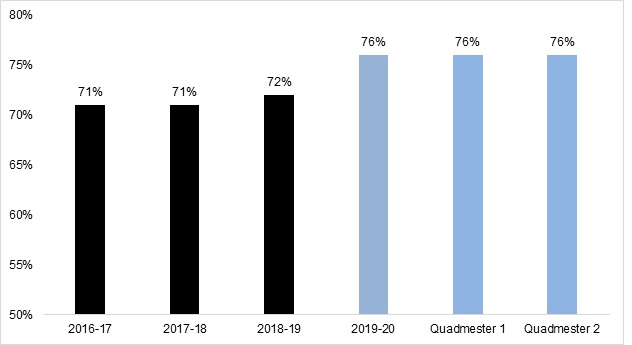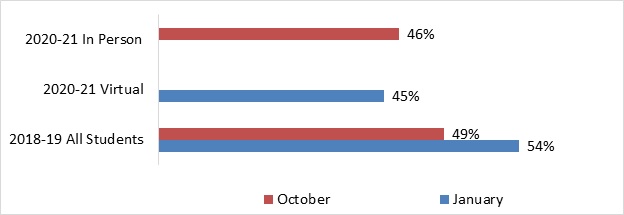Preliminary findings were presented at the Toronto District School Board’s Program and School Services Committee on March 31, 2021. These findings focus on potential impacts on learning outcomes in Kindergarten to Grade 12 that have occurred as a result of the disruption to public education in the Toronto District School Board (TDSB) and many parts of the world due to COVID-19. Two important data sets have been used to begin this conversation: secondary school report card data and Grade 1 reading data.
Average Marks of All Grade 9 to 12 Credit Courses Taken by TDSB Students

Differing from some jurisdictions reported at the outset, TDSB secondary school report card marks have gone up by four percentage points since the pandemic began. Additionally, this average rise in marks has been sustained throughout Quadmester 1 and 2.
Percentage of Students Meeting Grade Level Expectations in Grade 1 Reading Assessments in a Quarter of the Schools

The percentage of students meeting grade level expectations is illustrated through the use of two different assessment tools: the Developmental Reading Assessment (DRA) and Prince Milburn (PM) Benchmarks, at two different times of the year (October and January), for the same sample of a quarter of TDSB schools. The reading data drawn from 2018-19 for these schools serves two purposes in this analysis:
-
It provides a pre-pandemic comparison at two different instances a half school year apart.
-
It provides an example of a percentage point change in proportions of students meeting grade level expectations before and during the pandemic in order to consider a preliminary system growth rate in reading achievement for Grade 1 students.
Factors Contributing to the Differences in Grade Averages and Mark Ranges
-
The TDSB has set assessment policies during the pandemic that may have affected how teachers approach summative assessments and grading in general.
-
Assessment and learning in the virtual environment are different than in person. While there are less available social inputs in virtual learning, there are also a variety of different virtual platforms and opportunities to demonstrate learning.
-
It may be more challenging for students to engage in virtual classroom spaces. Students across Grades 6-12 in the TDSB report significantly lower levels of classroom engagement in the virtual space compared to pre-pandemic questions on classroom engagement.
-
In secondary schools, culminating activities designed to provide opportunities for students to demonstrate understanding of course content now include a broader range of possibilities. In the TDSB, final exams have been reduced to very few or none during the pandemic.